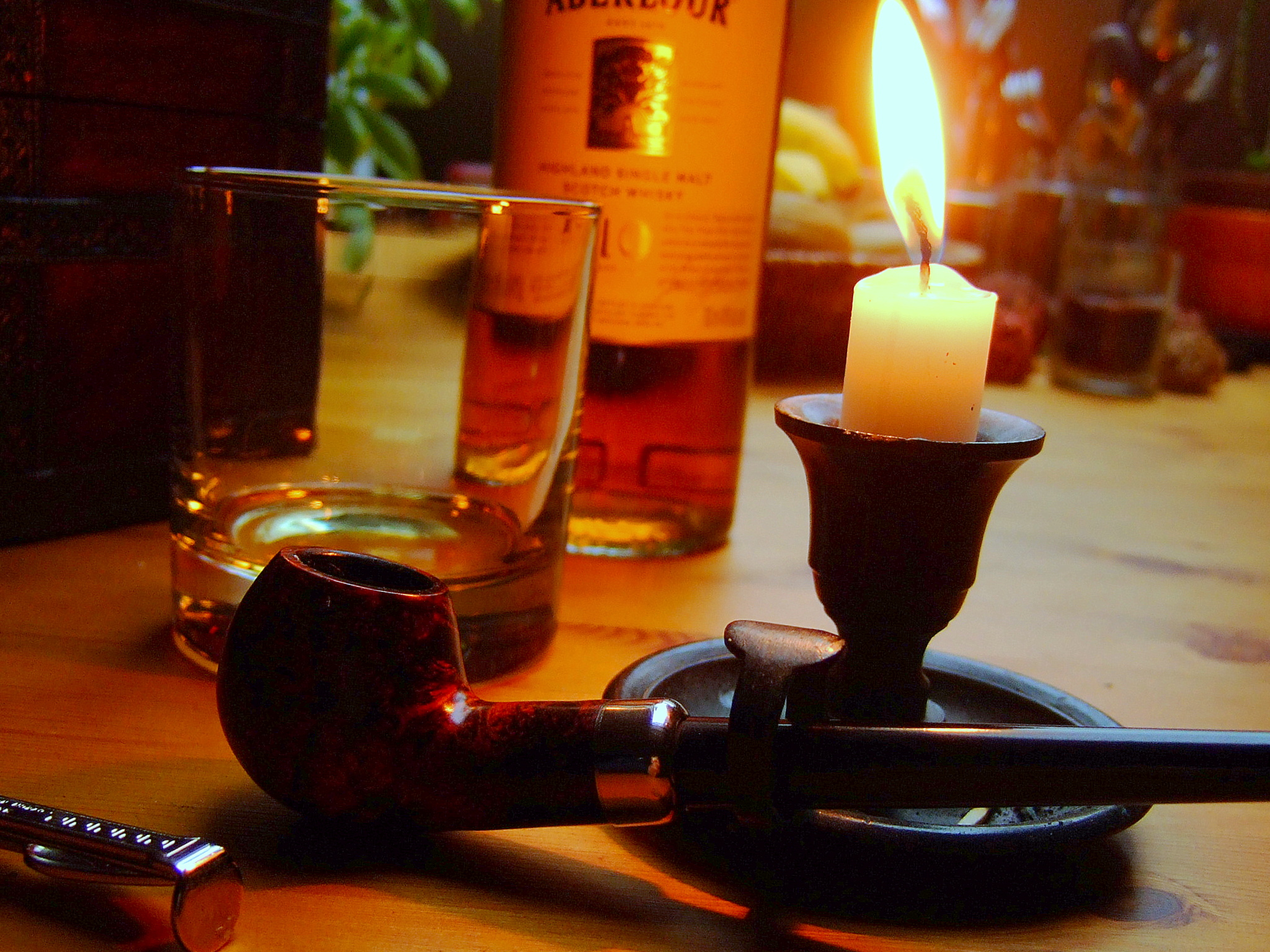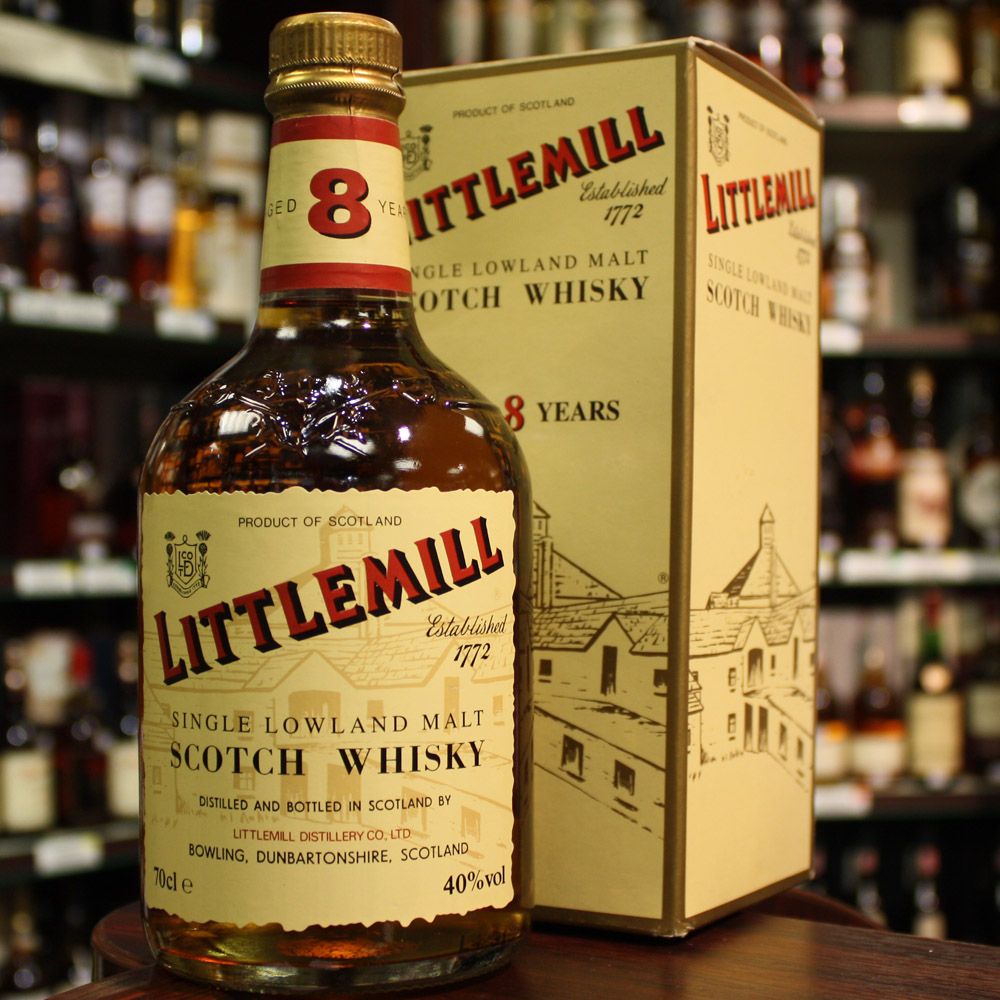 Once in a while, mostly late in the evening when Ellen is already asleep, I like to indulge myself with a glass of good whisky. Often in combination with a pipe. Unfortunately I know very little of this distilled alcoholic beverage that is made from fermented grain mash, only that I like it. What I do know is that I enjoy a glass of peaty 16 year old Lagavulin paired with a pipe filled with leathery, smoky Penzance. Hmm.. I wondered.. Would there be more combinations possible between whisky and tobacco?
Once in a while, mostly late in the evening when Ellen is already asleep, I like to indulge myself with a glass of good whisky. Often in combination with a pipe. Unfortunately I know very little of this distilled alcoholic beverage that is made from fermented grain mash, only that I like it. What I do know is that I enjoy a glass of peaty 16 year old Lagavulin paired with a pipe filled with leathery, smoky Penzance. Hmm.. I wondered.. Would there be more combinations possible between whisky and tobacco?
The man to ask this question to is Paul, who some of you may know from the “Who’s afraid of chemistry part 1 and 2” posts. Besides pipe smoking he also enjoys a good whisky. Well, several good whiskies. Ok, a lot of good whiskies. The man is a walking whisky encyclopaedia and has bottles and bottles of the finest “water of life” at home. Paul also does so called “nosings and tastings” in which, together with a selected group of people, he discusses how to distinguishing smells and tastes with whiskey. He also provides background information about the production process, the components of the distilleries, specificities of whisky, whisky regions and distilleries, wood and barrels, water and peat, boilers, other technical aspects etc. So I asked him to write a post about which whisky goes best with which tobacco. Before I let you read the piece Paul wrote I have to mention that throughout his story I linked to whisky reviews. Now not every reviewer thinks the same about a whisky (the same goes for tobacco) so all opinions and recommendations are Paul’s and are based on his knowledge and vast experience.
 For this article I want to write a bit about one of my other passions besides pipe-smoking: whisk(e)y. Arno has asked me: which whisky goes best with which tobacco? Hmmm, tough question to answer, because one person likes to adjust the tobacco aromas with the whisky aromas and another likes some contrast in tobacco and whisky while enjoying them together.
For this article I want to write a bit about one of my other passions besides pipe-smoking: whisk(e)y. Arno has asked me: which whisky goes best with which tobacco? Hmmm, tough question to answer, because one person likes to adjust the tobacco aromas with the whisky aromas and another likes some contrast in tobacco and whisky while enjoying them together.
My specific love goes out to the Scotch single malt whiskies, so you will find them in my examples. But in this article I will occasionally mention the Irish and the American whiskeys too; sometimes with a specific brand-name and expression, sometimes as a group. In Scotch single malt whiskies 400 (four hundred) aromas have been found, so you will understand I can only give “some” guidance on brands and expressions. There are about 10.000 – 12.000 Scottish single malt expressions on the market, including the many independent bottlings. A list way too big to insert them all in this article. So please look upon the following tips and names as a first direction you can follow. For specific questions I will gladly be of service to answer anything on the subject of whisk(e)y. You can use the e-mail on my website www.whiskyinfoplus.nl (in Dutch, but you will find the e-mail button).
For the purists on this heavenly brew, who might have noticed the “e” in the name of the drink: Irish and American whiskey is written with the “e” in the name, all the other whisky producing countries spell it without the “e”. If generally mentioned I will write whisky in this article as the Scots do. If I mean specific Irish or American whiskey, you will notice the extra “e”. A final remark upfront: “yo” is not only a rap-word from guys like 50-Cents and others, but stands for “years old”, which is the age statement of the whiskies ageing in the casks.
AROMATIC BLENDS:
– vanilla and caramel:
Most American Bourbon and Tennessee whiskeys have quite some vanilla/caramel aromas, which go perfectly with a vanilla flavoured tobacco.
As do a lot of Irish whiskeys, such as Bushmills 16 yo, Magilligan 5 yo, Greenore 8 yo and Redbreast 12 yo.
Most Scotch single malts have aged in ex-Bourbon or ex-Tennessee casks and they almost always have aromas like vanilla, caramel and/or butterscotch. Like Glengoyne 12 yo, lots of The Macallan expressions, Deanston 12 yo, The Glenlivet and Glenfiddich single malts up to 15 yo. This also goes for most of the brands from the Speyside region, as long as they have matured on casks formerly used by American whiskey makers.
– honey:
A lot of whiskies can have some honey aromas, i.e. Drumguish (from the Speyside distillery, no age statement on the label), Speyburn Solera (which combines the honey with oranges) or The Macallan Fine Oak 10 yo.
– orange/grape/citrus:
An aroma which also can be found in Scotch single malts, like Oban 14 yo, Speyburn Solera, Old Pulteney 12 yo (grape/orange like aroma) and Fettercairn Fior.
– red fruits like berries, raspberry, blackberry, etc.:
Tomatin 25 yo has a few expressions with berry-aromas. Further you have Springbank 13 yo Port Cask, Lochside 10 yo and Glencadam 15 yo.
– floral aromas:
Glenturret 10 yo brings out some floral notes, as well as a lot of whiskies which have matured on ex-sherry casks, like Glengoyne, Genfarclas 15 yo, Mannochmore 12 yo, Glenmorangie Lasanta 12 yo, Benriach 12 yo, Aberlour 12 yo and most whiskies which boast “matured in Oloroso/sherry/Pedro Ximenez casks” on the label.
VIRGINIA BLENDS:
Almost all of the time an Irish whiskey matches perfectly with Virginia tobacco. There are far over 100 Irish whiskeys, blends, single malts, single grains, pot stilled or continuously distilled whiskeys. All with their own specific character but mostly a bit more “friendly & easy-going” in taste and aroma than the average Scotch single malt. You almost can’t go wrong combining a Virginia tobacco filled pipe with an Irish whiskey.
Scotch whiskies from the Lowlands also combine fine with the light sweet aroma of a lot of Virginia tobaccos. Think of Lowland whiskies like Auchentoshan 12 yo, Littlemill (if you still can find it, the Littlemill 8 yo has a typical aroma of a freshly mowed lawn), Bladnoch and Glenkinchie. But a Speyside region whisky like Knockdhu 12 yo or a young (under 15 yo) Knockando will do just fine as well. Ever tried Highland whiskies like Deanston 12 yo or Dalwhinnie 15 yo to go with your Virginia tobacco? Both, with their heathery and sweet notes, will bring out the sweetness of your Virginia pipe tobacco.
This post continues in part 2.










Hi Paul, have you tried a good American rye? There are probably some nice combinations to be found there too. http://www.drinkspirits.com/whiskey/best-rye-whiskey/
Hi Arturo,
Not yet. My main interest goes out to the Scottish single malts and of course some whiskies from other countries have been tried and tested. There are simply too many whiskies to taste them all. So an American rye has not yet have paused under my nose. Thanks for your remark, I will try one soon. Any recommendations? Best regards, Paul.
I’ve only tried a few, two of which were in the review I linked above (which seems to have gotten them right). The Michter’s tastes as much like corn as rye, but isn’t bad at all. The Buillet is very, very good, especially for the price. I also like Sazerac, which wasn’t reviewed. If you have any trouble finding them, maybe we can work out a Rye-for-Semois trade? 🙂
Re the leathery Penzance, I have an old Longchamps pipe that (still) throws off a strong smell of leather. Adds a really nice dimension to whisky and tobacco. Cheers!
Just noticed in the comments of that review that Rye seems to appeal to scotch lovers; perhaps because they’re both grain rather than corn based?
Corn is, for distillation purposes, a kind of strange grain, compared to rye, barley, wheat, etc. Corn contains a lot of starch (which is important for mashing where starch becomes sugar), but corn lacks a lot of other minerals, proteïnes and stuff, that is needed during fermentation (when the yeast is added to the sugery water from the mash-process). All those proteïns, minerals, etc. are needed as “fuel” (or food) for the yeast. So, wort (the sugery water which is the product of from the mash-process) from corn, behaves different during fermentation than wort of other grains which DO contain all the extra “side-dishes”. This will affect the product of the fermentation (which is called “wash”) in aromas, because other molecules have been produced. So, the side-dishes like proteïnes, etc. are an important part of why whisky made from corn is different than whisky from other grains.
And there are a lot more of those differences, but hey: let’s not go into the chemicals about producing whisky too deep. 😉
Haha, regarding the “trade’, where are you living? Can be tricky to exchange alcohol or Tobacco across some borders, like from within the EU where I’m living to somewhere outside it. But I will try to get a hold on that The Buillet.
Regards, Paul.
Arno should have my email address now. If you have any trouble, let me know, will be happy to ship some ‘educational materials’ your way!
Arno has sent me your e-mail. I will write you via e-mail later today.
Pingback: 9 Essential Whisky Facts To Make You Sound Like An Expert | シ最愛遲到.!
Pingback: Community Post: 9 Essential Whiskey Facts To Make You Sound Like An Expert – IMA